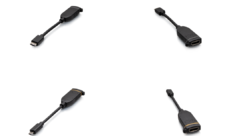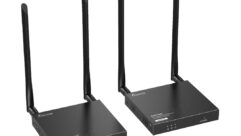

HDMI Alternatives Come to Light
If HDMI connectivity woes have you down, take heart. Alternatives to the high-definition standard are taking shape and their proponents are positioning them as a more network-friendly solution.
Its no secret that our industry is less than fond of the High-Definition Multimedia Interface (HDMI). We grumble and complain about it, then stumble along trying to switch, distribute, and route the “four-letter word” to projectors, LCD monitors, and other AV peripherals.
Pete Putman
Like it or not, HDMI is an integral part of our industry. And with analog “sunsets” looming for set-top boxes and media players, our reliance on HDMI is only going to increase. DisplayPort has done little to stem the tide because it is designed by committee—and a large one at that. While the Video Electronics Standards Association has been busy the past five years holding meetings, developing standards, negotiating patent royalty agreements, and issuing press releases, HDMI Licensing and its parent company Silicon Image have rolled through four iterations, including a new set of (evolving) 3D formatting standards, and three different versions of the HDMI connector.
What other alternatives are there to HDMI? One is wireless connectivity, such as the WHDI (Wireless Home Digital Interface), which can stream video at data rates up to 3 Gbps (including uncompressed 1080p) using a 40-MHz channel in the 5-GHz band with a range of 100 feet. There’s also WirelessHD, based on a 7-GHz channel in the 60-GHz Extremely High-Frequency band.
There are wired, bi-directional alternatives to HDMI. On June 29, the HDBaseT Alliance, yet another industry association, announced its incorporation. This group, made up of LG Electronics, Samsung, Sony Pictures (not Sony Electronics), and Valens Semiconductor, is pushing an all-digital interface over Cat-5e/6 cable up to 330 feet (100 meters). You can read more at www.hdbaset.org.
Don’t confuse HDBaseT with UTP signal transmission. HDBaseT is a 100-percent digital transmission system which, according to the group’s press release, “has the bandwidth to support the highest video resolutions such as full HD 1080p, as well as 3D and 2Kx4K formats. HDBaseT is the first to provide all-in-one connectivity, making it possible for a single-connector TV to receive power, video/audio, Internet, and control signals from the same cable.”
Sounds suspiciously like HDMI 1.4, doesn’t it? But there are differences. The goal of the HDBaseT Alliance is to promote the use of inexpensive, garden-variety Cat-5e as a do-it-all interconnect between components in a home entertainment system, such as multiple TVs driven by one DVR or Blu-ray player. Of course, running HD video over Cat-5 cables isn’t new. You can buy converters that will transport HD-SDI streams through UTP cabling, but like HDMI itself—and unlike HDBaseT—that’s a point-to-point solution requiring a content source at one end and either a display or a distribution system at the other. Basically, HDMI still bedevils us all when we try to route or switch it from multiple sources to multiple endpoints.
Apparently there will be no such problems with HDBaseT, which the group says is ideal for commercial applications such as digital signage. The key difference is that, unlike HDMI, HDBaseT advocates a networked, distributed approach from the start, something manufacturers have been trying to push into the home ever since “home media server” fell off someone’s lips. Only recently has HDMI even added Ethernet support.
The HDBaseT Alliance anticipates products with embedded HDBaseT technology to be available in the second half of 2010, with the majority of adoption taking place in 2011.
Attacking from the East flank
But HDBaseT isn’t alone in assaulting HDMI’s position. In April, supporters of the Digital Interactive Interface for Video & Audio (DiiVA) held their first developer’s conference in Guangzhou, China. As described on DiiVA’s website (diiva.org), “Uncompressed video, audio, USB, Ethernet, device control, content protection, power delivery, and power management are coordinated throughout the DiiVA network. As a result, DiiVA streamlines and simplifies the interface technology in the home, providing ease-of-use and helping users maximize their multimedia entertainment experience.”
Sounds a lot like HDBaseT! The big difference between DiiVA and HDBaseT is the former’s proprietary cabling and connector scheme. DiiVA also promises a different level of interactivity. For example, with DiiVA, video games located on any console or computer can be played on a TV through its USB port. (You had noticed that more TVs are equipped with USB ports these days, right?) In addition, mobile devices can use a DiiVA connection to charge while simultaneously playing back video and audio, and PC-based applications can be launched directly from DiiVA-connected TVs.
Who’s behind DiiVA? Many of the usual suspects, including Sony, Samsung, Panasonic, Sharp, LG, and Toshiba, plus a long list of Chinese electronics makers, such as Foxconn. Doesn’t ring a bell? Foxconn builds iPods and iPads for Apple.
The fact is, there are more than a few groups taking up arms to replace HDMI with a full-blown, wired or wireless, networkable digital pipe that not only carries AV, but also emulates USB, sends and receives commands, and even transmits power to remote devices. Looking at the big picture, that’s where our industry is headed. HDMI may be a secure interface, but it’s designed as a single-player-to-single-display connection. And that’s not how media distribution looks like these days.
I can see the defenders at HDMI Licensing raising the drawbridge now.
Pete Putman is a Pro AV senior contributing editor and former InfoComm Education of the year. His new Pro AV e-newsletter, Wake-Up Call, covers all things digital video.










